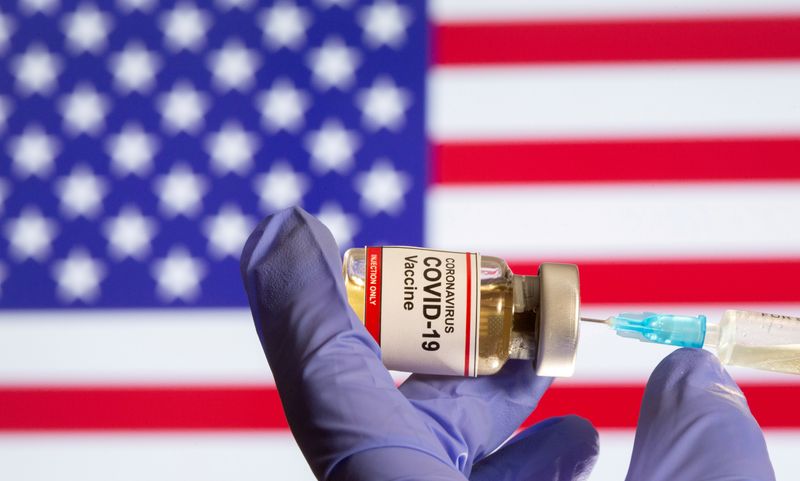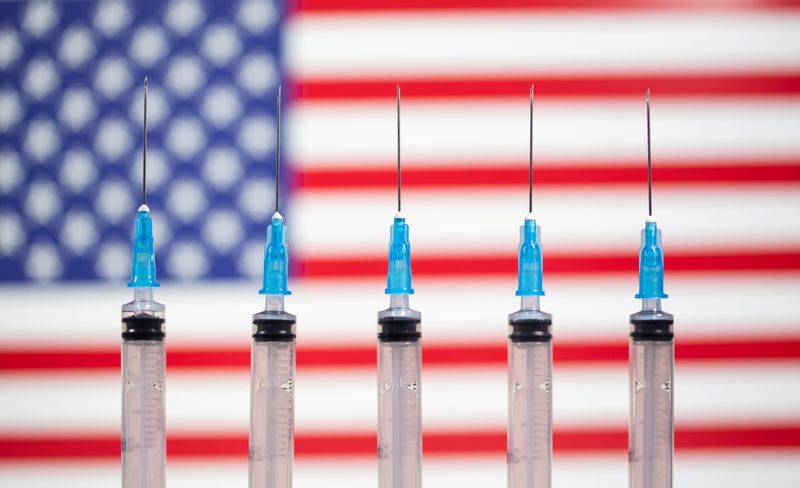By Tina Bellon and Richa Naidu
NEW YORK/CHICAGO (Reuters) - Companies and industry groups lobbying to get their U.S. workers to the front of the line for COVID vaccination are running into a patchwork of state plans and confusion over who is essential, and who is not.
Inoculation against the disease caused by the novel coronavirus is key to safely reopening large parts of the economy and reducing the risks of illness at crowded meatpacking plants, factories and warehouses.
But before one needle has entered the arm of an American worker, confusion has broken out over who exactly is considered essential during a pandemic.
With initial vaccine doses limited and strong federal guidance lacking, it has fallen to U.S. states to determine who will be first in line to receive a vaccine, and who will have to wait well into next year.
State vaccine distribution plans reviewed by Reuters showed broad discrepancies over who would be considered essential, with some states clearly outlining specific worker groups and others not providing any clarity.
Generally, states have broad discretion when it comes to vaccine distribution and policy and are able to issue vaccination mandates for their residents.
Many states have so far followed federal guidance to give meat and food processing industry workers space in the line, but some are slowly moving away, said Mark Lauritsen, a former hog slaughter worker who now advocates on behalf of about 250,000 meatpacking and food processing workers under the United Food and Commercial Workers union.
"For example, Colorado has not moved meatpacking and meat-processing as high as some other states. So we'll be directing a lot of our effort towards places like Colorado where we may be moved down the food chain."
"We're a union that has members in every state so we will be talking to every state to make our case as to where our place in line should be...Everybody is going to be jockeying for a place in line."
More than 20 large industries have urged officials to prioritize their workers, including individual companies such as ride-hailing company Uber Technologies (NYSE:UBER) Inc and food delivery provider DoorDash Inc and industry groups representing truck drivers, teachers, retail workers and other business sectors.
DoorDash in its letter calling for preferred vaccine access for its delivery workers said the company could also help public health officials communicate vaccine information through its platform.
At least 22 industries, including agricultural companies, cleaning suppliers, dental hygienists, bus drivers and meat packers, also have written to the Advisory Committee on Immunization Practices (ACIP), an independent panel of health experts recommending vaccine distribution guidelines to the U.S. Centers for Disease Control and Prevention.
WHO IS ESSENTIAL?
"We're hopeful that local health officials start jumping on this quicker rather than later so that there's some guidance and some better sense of how to be efficient with the essential workforce," said Bryan Zumwalt, executive vice president of public affairs for the Consumer Brands Association.
The group representing consumer products makers including Procter & Gamble (NYSE:PG) Co and Coca-Cola (NYSE:KO) Co, has sent letters to nearly all 50 U.S. states and federal officials, urging their nearly 1.2 million workers to be prioritized for a vaccine.
ACIP to date has only recommended healthcare personnel and residents of long-term care facilities should receive the vaccine first - a priority not disputed by any industry or state. ACIP members did not respond to a request for comment or declined to comment pending the discussions.
While some states have said they would await the committee's further recommendations, others went ahead and developed their own vaccine distribution priorities, a review of COVID-19 vaccine distribution plans showed.
U.S. President-elect Joe Biden has criticized President Donald Trump's lack of a coordinated plan to distribute coronavirus vaccines, but it is not clear whether the federal government could overwrite state distribution plans.
In New York, essential frontline workers regularly interacting with the public, such as pharmacists, grocery store workers and transit employees, are slated to receive the vaccine in a second distribution phase, while Florida included all essential workers on a U.S. Homeland Security list.
But that Homeland Security department list, spanning more than 25 major industries, makes up nearly 70% of the U.S. labor force, according to researchers at the National Bureau of Economic Research.
Georgia's plan said the state was working with various industries, including poultry plants, manufacturers and warehouse distributors.

In North Carolina, which has one of the most detailed distribution plans spanning nearly 150 pages, workers in meatpacking, seafood, poultry and food processing, transportation and retail would be included in an early phase so long as they had at least two chronic conditions that put them at high risk.
Pennsylvania's distribution plan on the other hand only includes three pages, stating merely that those "contributing to the maintenance of core societal functions" would be prioritized.
